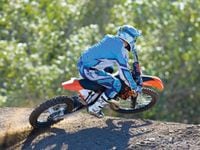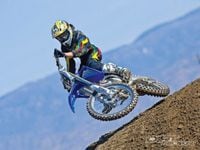A lot of you might be overlooking some of the best bikes out there. Sure sales figures and what your buddies brag about may contradict what your friends here at Dirt Rider Magazine are going to tell you, but remember, we are the experts and we've ridden everything. Two-stroke 125cc motocrossers, and the 144cc and 150cc "cheater" versions of these bikes, might be the best all-around value and provide the highest fun factor on two wheels today. And value and fun are two things we can all really use more of these days.In terms of sheer performance, the 125 hasn't kept up with the rapidly evolving 250cc four-stroke. Whoever thought a 250cc thumper could run that good? No one did about 12 years ago, which is why they were allowed to race straight up against the 125. The four-stroke has more peak power, but more importantly almost twice the usable power spread in rpm, the latest innovations in handling and suspension, as well as its double dose in displacement. But four-bangers also have higher maintenance demands and increased costs that grow over time with more necessary replacement parts. Plus, motor failures are often catastrophic, especially for mechanically challenged owners. On the two-stroke side of the fence, the Yamaha YZ125 has an aluminum frame and top-flight suspension components while KTM has kept two-stroke development alive with continuing improvements each year. The chassis and suspension components on both the 125 and 150 KTMs are the same as on all of the SX line. These Yamaha and KTM models are the only readily available small-bore two-strokes as Honda, Kawasaki and Suzuki chose to discontinue selling 125s in the U.S. Whether we will continue to have 125s as a choice depends solely on how they sell-pretty simple.Who are these bikes best for? They are perfect for riders outgrowing an 85cc race bike or even riders outpacing their midsize four-stroke trailbike like a Honda CRF150F or Yamaha TT-R125. Compared to the other race bike choices, a 125 is much easier to control for lighter riders, and much smarter than jumping all the way up to a 250cc four-stroke MXer. Consider that a 125 starts a lot easier, has less power to get riders into trouble and it takes more skill to ride them fast, therefore riders learn to be better operators on their first full-size machine. Clutch control is vital, and being in the right gear is paramount on 125s-what better way to learn to get the most out of your ride? The bike's light weight, combined with less rotational mass inside the engine cases affecting the handling of the bike, makes it easier to control and teaches riders to move the bike around without having to be incredibly strong. A 125 is surely one of the best bikes for the first-time rider to be looking at for the same reasons mentioned above.Then there is a small but growing group of older riders who at one time raced or rode 125s and are going back, just for fun. Typically lighter riders, too small for a 250cc two-stroke but over the four-stroke fever (or at least taking a break). The small-bore two-stroke is a refreshing memory and still an absolute blast to ride and race, even if you are slower on it. (A great reason to talk your friends into this crazy idea as well.)Dirt Rider hit the tracks with KTM's latest offerings and the 2009 Yamaha YZ125. To that we added our 2008 YZ125 that had been outfitted with an Athena 144cc kit (www.athena-ad.com) and an FMF exhaust (www.fmfracing.com), rounded up test riders young and old, and had a match-up of mega-fun proportions, just small on displacement.Cameron Kyler:
120 lb Novice
Uses wood blocks because he can't touch the ground on the start line.Chris Plouffe:
115 lb Intermediate
Drove the whole way to the track with the window down, rolling learner's permit style.Sean Foos:
120 lb Novice
Yes, his mom drove him to the track. Yes, he's rocking a new set of Fox gear, too.Chris Barrett:
180 lb Pro
Be cool, he rides the supercross class!Jimmy Lewis:
185 lb Vet Pro
Sporting a nice dirt beard from a life of eating roost.Tyler Ruiz:
180 lb Intermediate
Sticks his tongue out and makes 125 noises all the time.
KTM 125 SX
Price: $5998
Claimed Weight (no gas): 200 lb
Seat Height: 38.8 in.
Fuel Capacity: 2.1 gal.KTM's smallest full-size motocrosser gets all of the great suspension advances that have catapulted its four-stroke brothers up in comparison rankings, and the upgrade seems to have done the same thing for our test riders on the 125 SX (and 150 SX as well). And that is only complemented by an engine that is putting out the kind of power it took to take down four-strokes for the 125cc Outdoor National title in 2003. The KTM 125 has a very smooth-building power spread that has an exceptional amount of torque and a slower-revving build that is very novice friendly. That lower part of the power is not where you'd race the bike or where an experienced pilot would ride it, but it is there and something novices will appreciate. But once you get the bike up into the revving portion of the powerband it really comes alive-but smoothly, and it pulls long and hard all the way through a great top-end. There is plenty of overrev, and it can scream or pull the next shift with ease. Jetting was perfect and crisp, and the hydraulic clutch action was as good as it gets.The KTM 125 has a very light feel, the lightest of the bikes in this group. It also has great steering and turning, letting the rider go anywhere on the track. The suspension seemed set perfectly for riders in the 150-160 pound range but wasn't so stiff that our lighter riders got bucked around too much. And like its bigger brothers, the bottoming was controlled, even with our tanky 180-190 pound riders. The SX is thin and the rider compartment is widely adjustable with a multiposition top triple clamp.KTM 150 SX
Price: $6198
Claimed Weight (no gas): 200 lb
Seat Height: 38.8 in.
Fuel Capacity: 2.1 gal.The bigger brother to the 125, the 150 SX is a lot more different than the added 25cc might suggest. There isn't much more torque on the bottom, in fact it feels like there is a little less. But when this bike comes alive in the midrange it really comes alive. It definitely feels like it is trying to bridge the gap between 125cc and 250cc two-strokes to 250cc four-strokes when it pulls like this (it feels stronger than even the KTM 200cc!), and it likes to lift the front wheel when you're hooked up and hauling. It is so aggressive that riders often needed to control the power with the clutch, not just boost it with that lever. The bike continues to pull hard up into the top, and it feels faster, as expected, than the 125. This is an expert-level type of power, and it is trying to keep pace with 250cc four-strokes. It might just be able to do that if the rider is quick enough with the shifting, but it will be a lot of work. For less experienced riders, look into flywheel weights to tame the little beast!With the added power the bike's suspension is asked to work harder, still this KTM delivers. Since the front wheel always seemed lighter, more attention was focused on the rear, and some of the lighter riders felt the 150 getting a little unstable on the choppy high-speed straights. The bike only feels slightly heavier in the flick and fling department, but it isn't actually heavier on the scale. The added power gives the bike a heftier feel when you are on the throttle. The brakes, like on both of these KTMs, are incredibly strong and have good control once you get used to the strength. The stock tires are intended for softer terrain, and work great if you have loam though they can be slippery on hardpack after just a little wear.
Yamaha YZ144
Price: $5599 + $819 + $348
Claimed Weight (no gas): 208 lb
Seat Height: 39.3 in.
Fuel Capacity: 2.1 gal.This 144 was an experiment in seeing if we could build the ultimate small-bore two-stroke and it took a lot of tuning, as we expected. For sure the KTM 150 is the easier path by having someone do the tuning for you, but here is our setup for the YZ144 (since we did it for you also). Along with the Athena kit, we found that is it pretty important to change the stock pipe and muffler for the best power spread. We had our best luck with a FMF Fatty pipe and PowerCore muffler. We also found ourselves working between stock jetting and up to two sizes larger on the main jet depending on the temperature and the altitude.With this setup the torque from the bottom to the top is boosted and the pull in the midrange is enhanced. Not near the top-end power level of the KTM 150, but it definitely beats it out in the bottom and the torque feel all the way through. This Yamaha was way more of a novice-friendly bike. It makes pulling out of the turns easier and keeping the dreaded bog at bay that much simpler. You end up using a lot less clutch, but the throttle response just wasn't as crisp or sharp as the YZ125's. (We did not have the chance to try some different reed valve systems which often fix this.) One of the best things about the 144 was that there was little, if any, difference in feel between the YZ125 and YZ144 in weight feel or handling. But in out-and-out racing with higher-skilled riders, there also wasn't much difference in the speed of the bikes, unless there were steep hills where the 144 would show its power advantage. For off-road or trail riding this is also a very potent package as the improved torque is very beneficial.Yamaha YZ125
Price: $5799
Claimed Weight (no gas): 208 lb
Seat Height: 39.3 in.
Fuel Capacity: 2.1 gal.Yamaha has kept the YZ125 alive with the most minor of updates for 2009, but that doesn't mean it is falling behind. That new front tire goes a long way! With very consistent handling and a suspension package set up perfect for 160-pound riders, the Yamaha is also adaptable to larger and smaller pilots. Our smaller guys found the Yamaha just a little bit less stable on the straights, but they were more comfortable in the turns. Since the YZ feels a little more planted than the KTMs and its handling just a bit more relaxed, they could get away with being less precise-something that riders who aren't that strong or are coming off an 85 can appreciate. The clickers on the YZ go a long way in tuning the ride, and with a little time almost everyone who rode the bike could get it to work. Riders 20 pounds on either side of 160 could get an even bigger boost by fitting stiffer or lighter springs.As for the motor, the Yamaha has a very potent and an incredibly snappy power delivery. It comes alive at a very low rpm and it has a pretty good punch fairly early in the power spread. Then it will snap to life at any rpm with a big crack of the throttle, provided you are in the right gear. Like any 125, if you are a gear high coming out of a turn, you are going to bog and all the clutching in the world isn't going to bring it back alive. The YZ has a really good pull that is broad in the middle and it tells you when it is time to shift with enough cushion on the top-end overrev. It doesn't like to pull as long and hard on top as the KTM 125, but the KTM 125 is not this robust in the middle.



/cloudfront-us-east-1.images.arcpublishing.com/octane/NCYHFQ2S3BAT7EC7VDN2ONGRTU.jpg)
/cloudfront-us-east-1.images.arcpublishing.com/octane/XQORS527YFFT3MVI326EOEYJUI.jpg)
/cloudfront-us-east-1.images.arcpublishing.com/octane/TVDPP3TGMZHODFXASIFUM2KD34.jpg)
/cloudfront-us-east-1.images.arcpublishing.com/octane/EWDMR3DDTBBQPI7DQVZCLMRFAE.jpg)
/cloudfront-us-east-1.images.arcpublishing.com/octane/4XHHLVOUKFE3PDSWNSV4JJMGOE.jpg)
/cloudfront-us-east-1.images.arcpublishing.com/octane/5RLI3NQKQJA3LKKCQHRXQFTL6Q.jpg)
/cloudfront-us-east-1.images.arcpublishing.com/octane/3QCYJCI2RNBENIRWAKEOEKHFUM.jpg)
/cloudfront-us-east-1.images.arcpublishing.com/octane/UZHF7KAE7BFN7KU734ER7PPP3Q.jpg)
/cloudfront-us-east-1.images.arcpublishing.com/octane/XJFFFMRN6VEZ7CDNAGKWVPC3H4.jpg)
/cloudfront-us-east-1.images.arcpublishing.com/octane/RMC3CHWSHFAUJA2WJ2FVG4NBOA.jpg)
/cloudfront-us-east-1.images.arcpublishing.com/octane/WXEZV4WAYBERFKSRE5M7GQBW7A.jpg)
/cloudfront-us-east-1.images.arcpublishing.com/octane/LO3PZVGICFGJZBNUA2ORUSAUSE.jpg)
/cloudfront-us-east-1.images.arcpublishing.com/octane/UFHLTNOXLVARVLZV32M6ZJZV4Y.jpg)
/cloudfront-us-east-1.images.arcpublishing.com/octane/CTSWNU7SNNCC3LWB2KATYZ5AXY.jpg)
/cloudfront-us-east-1.images.arcpublishing.com/octane/IBNGAQWHJJF4TKSIQT54MTWRYQ.jpg)
/cloudfront-us-east-1.images.arcpublishing.com/octane/EAEWHFARGVGHFH4N4BDOSNBJSU.jpg)
/cloudfront-us-east-1.images.arcpublishing.com/octane/AZ7H35TQSZDKZCVM4S6CHERQEU.jpg)
/cloudfront-us-east-1.images.arcpublishing.com/octane/GYMIU7SMN5CWHP6QLFR6MVKEBU.jpg)
/cloudfront-us-east-1.images.arcpublishing.com/octane/B3CX7C4BFFCKBLDWHPQFACBH2E.jpg)
/cloudfront-us-east-1.images.arcpublishing.com/octane/6EIBG7NN4BH4FKDBCPCTLQL6FU.jpg)
/cloudfront-us-east-1.images.arcpublishing.com/octane/3RBI4ZG5NNBCTEUK7MWMKVZ5BE.jpg)
/cloudfront-us-east-1.images.arcpublishing.com/octane/3QKLYI2BWVAMRNNFC5KCGUYRAU.jpg)
/cloudfront-us-east-1.images.arcpublishing.com/octane/B7ITEVP2MRGLXM37KQURRKCG3E.jpg)
/cloudfront-us-east-1.images.arcpublishing.com/octane/BMDGOMSLGFF7XDLBL5DVCTON6Y.jpg)